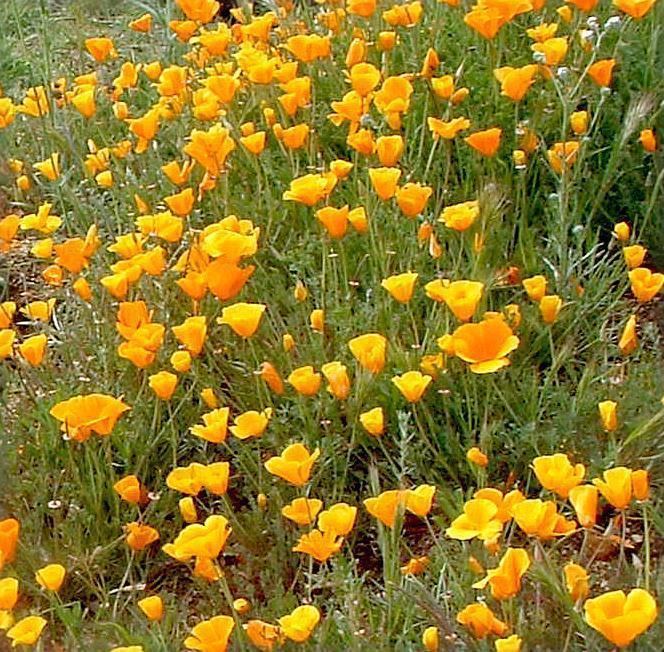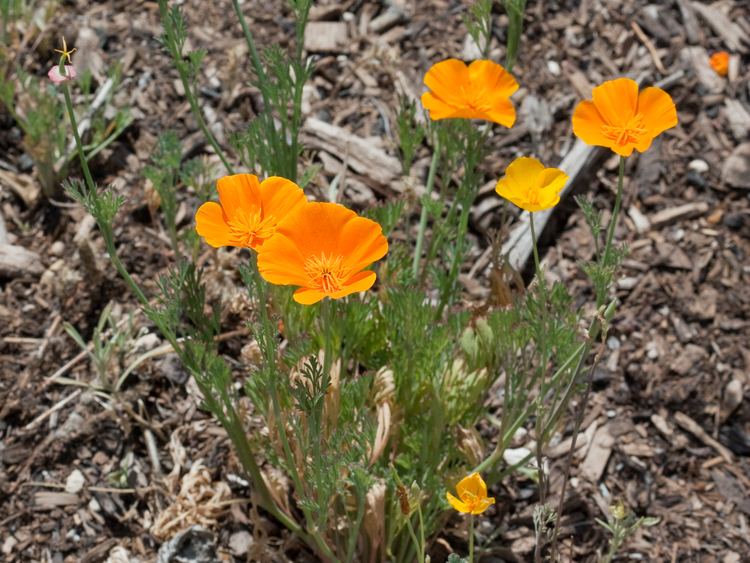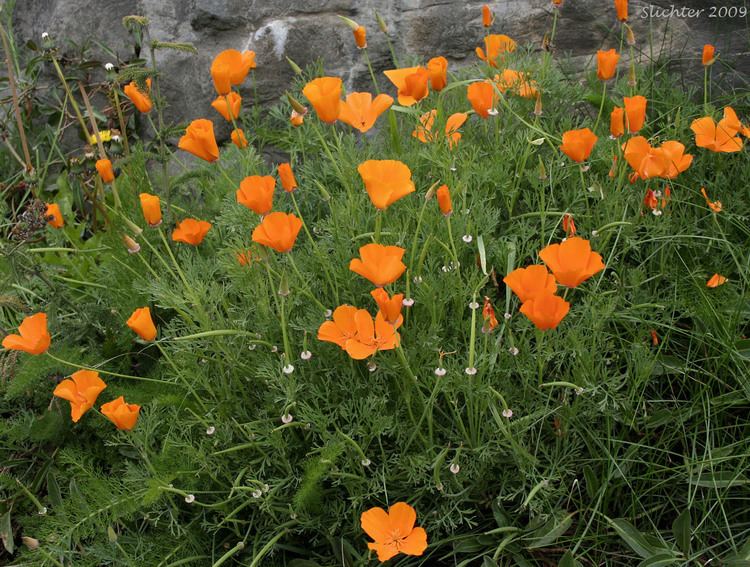Higher classification Eschscholzia | Genus Eschscholzia Rank Species | |
 | ||
Similar Eschscholzia, Common poppy, Poppy, Valerian, Papaveraceae | ||
Gardening tips flowers how to grow california poppy eschscholzia californica
Eschscholzia californica (California poppy, Californian poppy, golden poppy, California sunlight, cup of gold) is a species of flowering plant in the Papaveraceae family, native to the United States and Mexico. It is an ornamental plant and it is used medicinally and in cooking, and it became the official state flower of California in 1903.
Contents
- Gardening tips flowers how to grow california poppy eschscholzia californica
- California poppy eschscholzia californica
- Description
- Habitat
- Taxonomy
- Uses
- Cultivation
- Invasive potential
- Chilean population
- State flower of California
- References

California poppy eschscholzia californica
Description
It is a perennial or annual plant growing to 5–60 in (13–152 cm) tall with alternately branching glaucous blue-green foliage. The leaves are alternately divided into round, lobed segments. The flowers are solitary on long stems, silky-textured, with four petals, each petal 2 to 6 cm (0.79 to 2.36 in) long and broad; flower color ranges through yellow, orange and red (with some pinks ), with flowering from February to September in the northern hemisphere (spring, summer, autumn). The petals close at night (or in cold, windy weather) and open again the following morning, although they may remain closed in cloudy weather. The fruit is a slender, dehiscent capsule 3 to 9 cm (1.2 to 3.5 in) long, which splits in two to release numerous small black or dark brown seeds. It survives mild winters in its native range, dying completely in colder climates.
Habitat

Its native habitat includes California and extends to Oregon, Washington, Nevada, Arizona, New Mexico, Sonora and northwest Baja California. The Antelope Valley California Poppy Reserve is located in northern Los Angeles County. At the peak of the blooming season, orange flowers seem to cover all 1,745 acres (706 ha) of the reserve. Other prominent locations of California poppy meadows are in Bear Valley (Colusa County) and Point Buchon (San Luis Obispo County).
Taxonomy

Eschscholzia californica was the first named species of the genus Eschscholzia, named by the German botanist Adelbert von Chamisso after the Baltic German botanist Johann Friedrich von Eschscholtz, his friend and colleague on Otto von Kotzebue’s scientific expedition to California and the greater Pacific circa 1810 aboard the Russian ship Rurik.

California poppy is highly variable, with over 90 synonyms. Some botanists accept two subspecies — one with four varieties (e.g., Leger and Rice, 2003) — though others do not recognize them as distinct (e.g., Jepson 1993):
Uses
California poppy leaves were used medicinally by Native Americans and the pollen was used cosmetically, while the seeds continue to be used in cooking.
The plant is used as an herbal remedy: an aqueous extract of the plant has sedative and anxiolytic actions. The extract acts as a mild sedative when smoked, but the effect is far milder than that of opium because California poppy contains a different class of alkaloids:
"An aqueous alcohol extract of Eschscholzia californica has been evaluated for benzodiazepine, neuroleptic, antidepressant, antihistaminic and analgesic properties. The plant extract did not protect mice against the convulsant effects of pentylenetetrazol, and did not cause muscle relaxant effects, but appeared to possess an affinity for the benzodiazepine receptor. The extract induced peripheral analgesic effects in mice but did not possess antidepressant, neuroleptic or antihistaminic effects."
Cultivation
E. californica is drought-tolerant, self-seeding, and easy to cultivate. It is best grown as an annual in full sun and sandy, well-drained, poor soil. Horticulturalists have produced numerous cultivars with a range of colors and blossom and stem forms. These typically do not breed true on reseeding. Seeds are often sold as mixtures. The following cultivars have gained the Royal Horticultural Society's Award of Garden Merit:-
Invasive potential
Because of its beauty and ease of growing, the California poppy was introduced into several regions with similar Mediterranean climates. It is commercially sold and widely naturalized in Australia, and was introduced to South Africa, Chile, and Argentina. It is recognized as a potentially invasive species within the United States, although no indications of ill effects have been reported for this plant where it has been introduced outside of California. The golden poppy has been displaced in large areas of its original habitat, such as Southern California, by more invasive exotic species, such as mustard or annual grasses.
Chilean population
In Chile, it was introduced from multiple sources between the mid-19th century and the early 20th century. It appears to have been both intentionally imported as an ornamental garden plant, and accidentally introduced along with alfalfa seed grown in California. Since Chile and California have similar climatic regions and have experienced much agricultural exchange, it is perhaps not surprising that it was introduced to Chile. Once there, its perennial forms spread primarily in human-disturbed environments (Leger and Rice, 2003).
Interestingly, the introduced Chilean populations of California poppy appear to be larger and more fecund in their introduced range than in their native range (Leger and Rice, 2003). Introduced populations have been noted to be larger and more reproductively successful than native ones (Elton, 1958), and there has been much speculation as to why. Increase in resource availability, decreased competition, and release from enemy pressure have all been proposed as explanations.
One hypothesis is that the plant's resources devoted in the native range to a defense strategy can, in the absence of enemies, be devoted to increased growth and reproduction (the EICA Hypothesis, Blossey & Nötzold, 1995). However, this is not the case with introduced populations of E. californica in Chile: the Chilean populations were actually more resistant to Californian caterpillars than native populations (Leger and Forister, 2005).
State flower of California
During the 1890s Sarah Plummer Lemmon advocated for the adoption of the golden poppy as the state flower of California, eventually writing the bill passed by the California Legislature and signed by Governor George Pardee in 1903.
As the official state flower of California, Eschscholzia californica is pictured on welcome signs along highways entering California and official Scenic Route signs.
It was selected as the state flower by the California State Floral Society in December 1890, besting the Mariposa lily (genus Calochortus) and the Matilija poppy (Romneya coulteri) by a wide margin, but the state legislature did not make the selection official until 1903. Its golden blooms were deemed a fitting symbol for the Golden State.
April 6 is designated as California Poppy Day.
